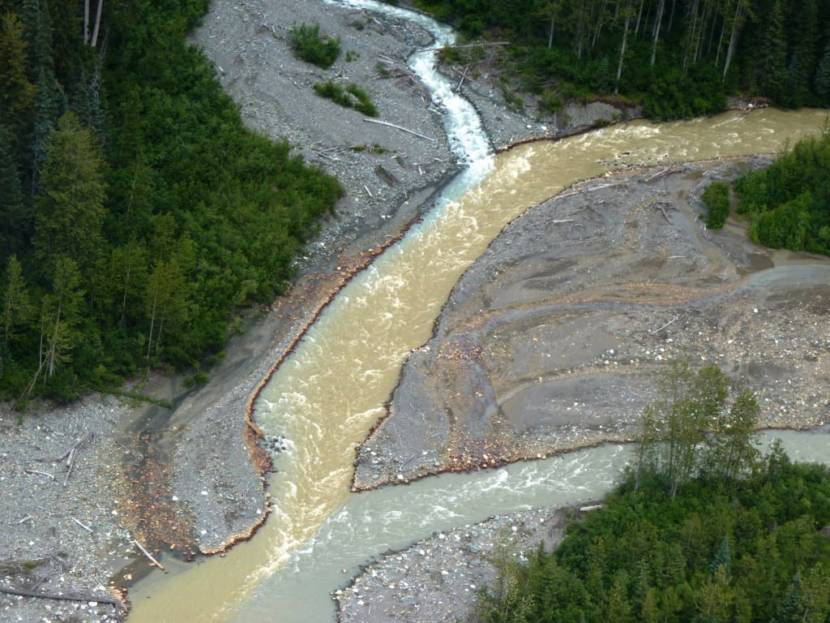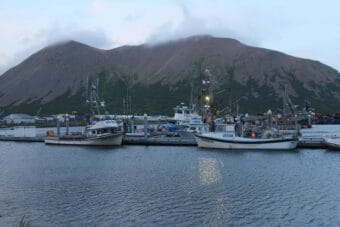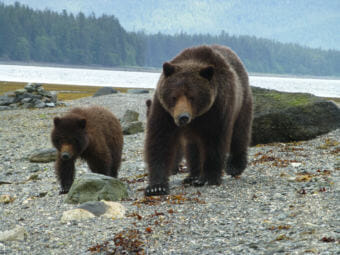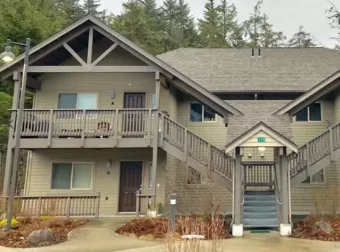
A 22-page final report released on Thursday culminates two years of data collected from water, sediment and fish tissue in three transboundary watersheds that straddle the frontier. And now, Alaska and British Columbia governments said their work is done.
“Given the existence of other sampling programs planned by state, federal or provincial agencies throughout the transboundary region, there is no need to continue the joint program,” the state and province said in a joint statement.
Congress appropriated more than $3 million for renewed stream monitoring at border stream gauges operated by the U.S. Geological Survey.
“With all the resources didn’t feel like it was necessary for multiple agencies to be collecting the same thing,” said Terri Lomax, a program manager with the state Department of Environmental Conservation.
She’s been part of the cross-border effort ever since Gov. Bill Walker signed a landmark agreement in 2015 with B.C. to set up joint water quality monitoring for a shared watershed. It hosts a booming Canadian mining sector upstream and drains into Southeast Alaska waters downstream.
“We’ve developed a lot of partnerships and a lot of relationships over the last couple of years,” she said. “We didn’t have these relationships with British Columbia.”
Provincial officials agree the program has run its course. Greg Tamblyn works in the regional water quality section at B.C.’s Ministry of Environment and Climate Change.
“Because of these established sampling programs in the region, continuation of the joint sampling program would really be redundant,” he said.
Transboundary watersheds as critical salmon habitat
But not everyone is convinced. Those who pushed for monitoring in the first place said they feel the state and province are letting themselves off the hook.
United Fishermen of Alaska said the state isn’t taking its responsibility seriously. The Taku and Stikine are significant salmon-producing rivers that have struggled in recent years. The fisheries are a key subsistence food source for Southeast Alaskans. And they generate significant economic value for commercial and charter fleets which have struggled in recent years.
“We have made every attempt possible to engage the State of Alaska on this issue, and the fact that they arrived at these premature conclusions is a disservice to Alaskans and the fishing communities of Southeast Alaska,” UFA’s Executive Director Frances Leach said in a statement Friday. “We need our federal delegation to elevate this issue to the highest levels.”
The final report said that two years of data found water quality standards weren’t exceeded on Alaska’s side of the border. There were times when certain heavy metals were over limits in sediment, but the report noted there are a lot of natural occurring minerals in the region.
Scientists who study these watersheds said a couple of years is a blink of an eye for dynamic river systems.
“You can’t measure a given site once or twice a year for two years and claim that you know the baseline watershed health of that area,” Chris Sergeant, a freshwater ecologist University of Montana’s Flathead Lake Biological Station.
The final report noted there was little evidence of contamination and aquatic life appeared healthy. But Sergeant said many of the mines Alaskans downstream are worried about haven’t been built yet.
“We have a lot of potential mines coming down the pike that are very large projects such as KSM, or Shaft Creek or Galore Creek,” Sergeant told CoastAlaska by phone from Seattle. “And so I’m looking at like, ‘Well, do we know what these metal patterns look like right now, and these rivers, in case those big projects are built and things change?’ And I just don’t think we’re set up for success to answer that question yet.”
The stream gauges such as those on the Unuk River operated by the U.S. Geological Survey are important, Sergeant said, but they’re only on Alaska’s side of the border. They don’t gather baseline data upstream, which could be used as an early warning signal for contaminants entering the watershed.
“The salmon swim right past that border, they go way up in those streams,” he said. “And there’s a lot of other, less catastrophic contaminants that can harm fish, and we’re just not measuring those things.”
Indigenous tribes push for more monitoring
Southeast Alaska tribes spurred the Walker administration to engage B.C. over transboundary mining. They said the commitment hasn’t survived the political transition following the election of Republican Gov. Mike Dunleavy.
“You know, we need, we definitely need, water quality sampling,” said Fred Olsen Jr., executive director of the 15-tribe Southeast Alaska Indigenous Transboundary Commission. “But we need ongoing, seasonal, sustainable sampling, we don’t need a couple years of hit and miss cherry picking the data, and then saying everything’s OK.”
The joint report cited a “well-established” monitoring program to collect data in the region run by tribes, including the Central Council of the Tlingit and Haida Indian Tribes of Alaska.
The tribe released a statement the following day and said it hadn’t been involved in the joint monitoring project since 2018. It urged the state and province to continue efforts even after the release of two years of data.
Tlingit & Haida vice president Will Micklin said the state and province’s two years of sampling is far from comprehensive.
“It is one step forward, it is not the end of the journey,” Micklin said. “This should not indicate to anyone that the testing is complete and more actions need not be pursued.”
Alaska and B.C. will remain in close contact: Greg Tamblyn of the environment ministry office in Smithers, B.C. said the existing cooperation pact remains standing, even after the joint-monitoring work ends.
“So that’ll help ensure a collaboration between the two parties and the long-term protection of the transboundary waters,” he said.
The cross-border workgroup established during Gov. Walker’s administration will continue to meet twice a year.



